
Evaluated Course of Handwriting Analysis
(Combination Traits)
How to Combine Several Basic Traits Into a New “EVALUATED TRAITS”
When we started learning graphology, we focused on basic traits, example:
i-dots = attention to detail
angle at bottom letter n = analytical, and more
(with their descriptions)
⇑⇑⇑
This is called : BASIC TRAITS
EVALUATED TRAITS
is a combination of some traits thus forming a new traits
⇓⇓⇓⇓
Teach you how to uncovering “hidden” personality traits
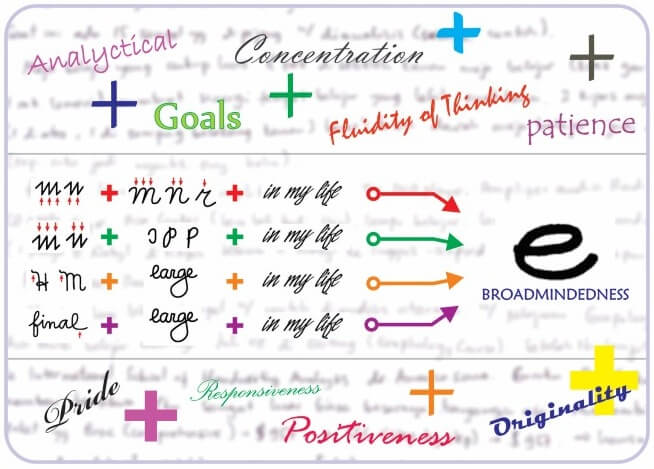

Dr. Karohs recounts:
“Many years ago, in one of my college handwriting analysis classes, one student thoughtfully scrutinized his signature, which looked like this:

Suddenly he shook his head and exclaimed:
“I’m not going to do this anymore.”
In response to our questioning looks he explained that he did not like the looped d’s and the personality trait of sensitiveness they stood for.
Eddie proclaimed that from this moment forward he would change his d’s. I tried to warn him that altering one particular letter could have dire consequences. But he was determined and started eliminating the loops.
Another student asked if this meant that Eddie suddenly would no longer be afraid of criticism.
I suggested that we should watch his handwriting carefully from now on.
After about two weeks the d’s were still carefully retraced but in addition a new stroke had crept into Eddie’s writing like this:

The letters ‘E’ and ‘h’ suddenly showed rigid initial strokes starting from below the baseline.
The students eagerly consulted their dictionaries (open the EVALUATED Book) and found to their surprise that:
Imagination strong (big loop in the h),
Plus impulsiveness (forward slant),
Plus resentment (long rigid initial stroke)
Equals SENSITIVENESS !!!
Eddie’s subconscious had played a trick on him. Not only was he still sensitive, he had now added the trait of resentment.”
⇑ ⇑ ⇑
Without knowledge of evaluated traits Eddie would have falsely assumed that he had conquered sensitiveness while in reality, the insidious fear would have continued to fester inside. (He then started a program of global grapho-therapy exercises (see our “Grapho-Cybernetics program on the BOOK page of this website) and in due time changed his overall writing in a more positive way.
The students, on the other hand, had learned a memorable lesson, namely, that hidden characteristics in handwriting can be EVALUATED through combinations of basic traits.
How the Evaluated Course is Organized &
What will you get with this course:
We hope that you will enjoy learning the fascinating science of handwriting analysis. It will not only teach you to know yourself better but also to get along better with people at home, at work and with people in general.
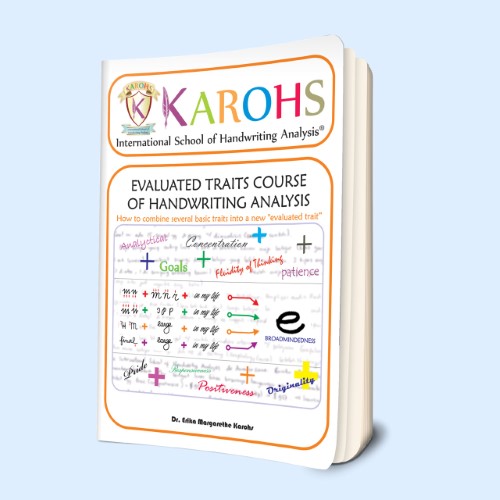
Book Manual: Evaluated Traits
- Divided into 2-part:
- Part I of the manual lists all the basic traits that are used as components of the evaluated traits listed in Part II
- Part II lists the evaluated traits.
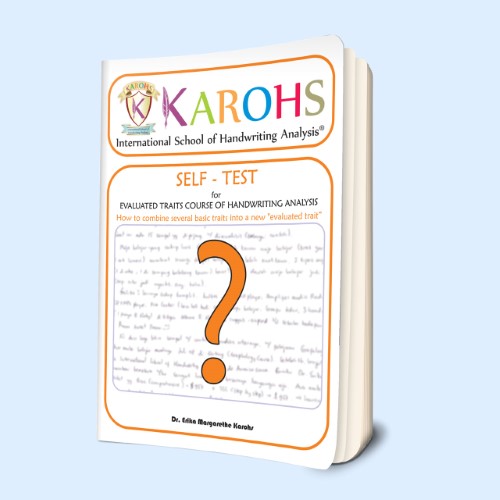
Book: Self-Test
- The course comes with 18 self-tests and model answers for each test.
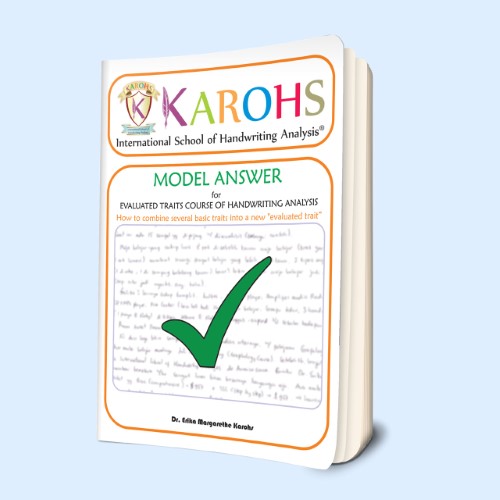
Book: Model Answer
- Using the “Course Outline” as a guide, study the traits for each lesson. Then complete the self-tests and compare your results with the model answers included with the course.
A professionally designed Worksheet
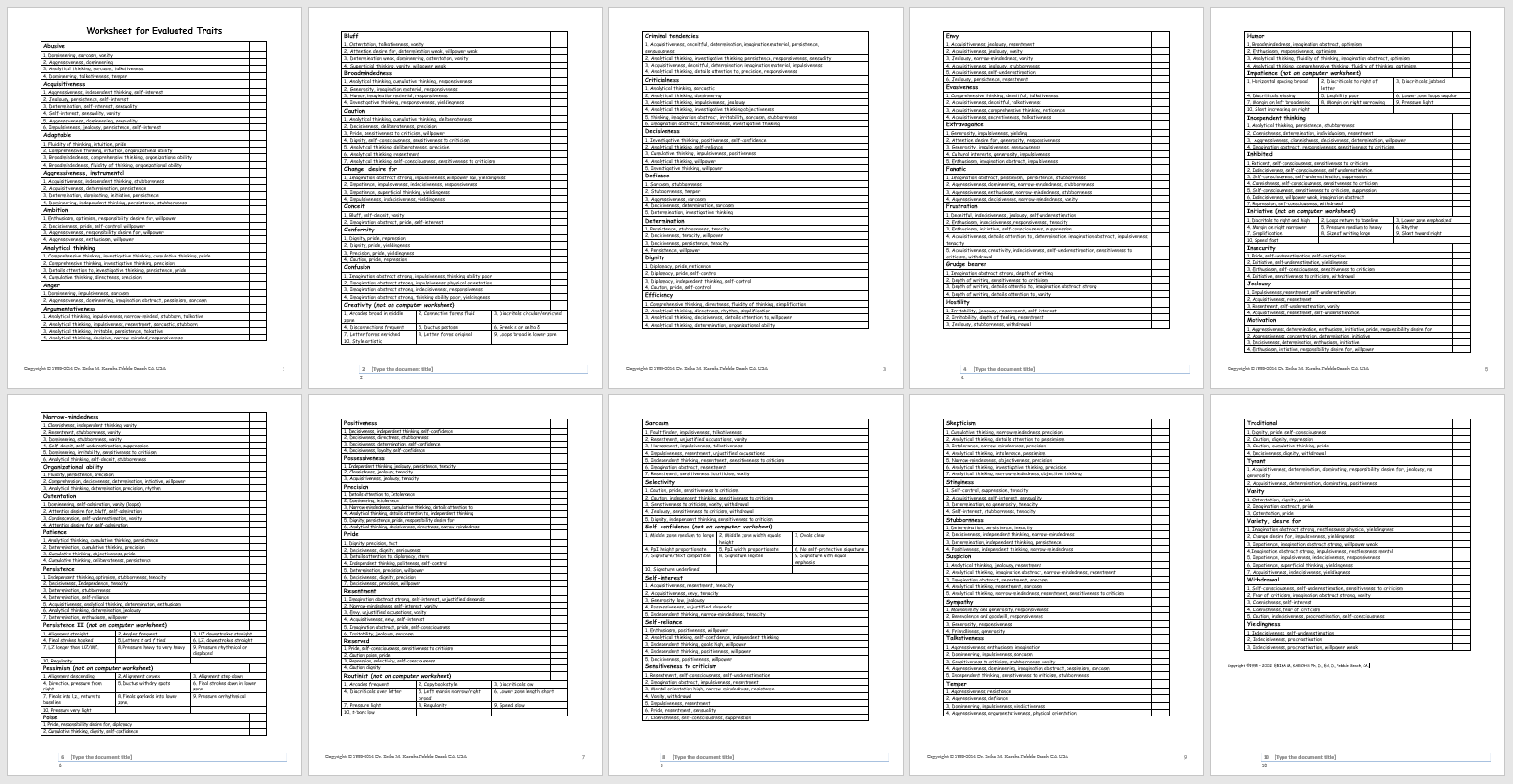
Detailed Lessons:
Part I: BASIC GRAPHOLOGY TRAITS
Lesson 1
Acquisitiveness, covetous, aggressiveness, analytical, argumentativeness, desire for attention, benevolence and goodwill, bluff, broad-mindedness, caution, desire for change, clannish, comprehension.
Lesson 2
Concentration, condescension, makes unfavorable comparisons, confusion, creativity, cultural interests, cumulative thinking, daydreaming, decisive, deliberate, depth of feeling, attention to details, determination.
Lesson 3
Dignity, diplomacy, directness, dominating, domineering, enthusiasm, envy, egotism, evasiveness, exaggeration, faultfinding, fear of criticism, fluidity of thinking.
Lesson 4
Frankness, friendliness, generosity, goals, grudge bearer, tendency toward harassment, humor, imagination, impatience, impulsiveness, inattention to details, indecisiveness, independence.
Lesson 5
Individualism, initiative, insincerity, intolerance, intuition, investigative thinking, irritability, easily agitated, jealousy, literary leanings, loyalty, faithful, magnanimity and generosity, manual dexterity.
Lesson 6
Mental orientation, narrow-mindedness, objectiveness, composure and equanimity, optimism, cheerful (being able to feel and spread happiness), organizational ability, originality, ostentation, patience, persistence, pessimism, sorrow, tendency to lament.
Lesson 7
Physical orientation, politeness, positiveness, possessiveness, precision, pride, procrastination, repression, resentment, reserved, resignation, resistance, desire for responsibility, responsiveness.
Lesson 8
Mental restlessness, physical restlessness, reticence, routinist, sarcasm, secretiveness, selectiveness, self-admiration, self-castigation, self-confidence, self-consciousness, self-control, self-deceit, self-interest.
Lesson 9
Self-reliance, self-underestimation, self-effacing, sensitive to criticism, sensual, sensuous, serious, shallow, showmanship, simplification, skepticism, stern, stubborn, superficial thinking.
Lesson 10
Suppression, sympathy, tact, talkativeness, temper, tenacity, unjustified accusations, unjustified demands, vanity, desire for variety, vindictive, willpower, withdrawal, yielding.
Part II: EVALUATED TRAITS
Lesson 11
- ACQUISITIVE,
- ANALYTICAL,
- ARGUMENTATIVE,
- BLUFF,
- BROADMINDED.
Lesson 12
-
CAUTION,
-
DESIRE FOR CHANGE,
-
CONFUSION,
-
CREATIVITY,
-
CRITICALNESS.
Lesson 13
-
DEFIANCE,
-
DETERMINATION,
-
DIGNITY,
-
ENVY,
-
EVASIVENESS.
Lesson 14
-
EXTRAVAGANCE,
-
GRUDGE BEARER,
-
HUMOR,
-
IMPATIENCE,
-
INHIBITED.
Lesson 15
- INITIATIVE,
- JEALOUSY,
- NARROW-MINDEDNESS,
- OSTENTATION,
- PATIENCE.
Lesson 16
- PERSISTENCE,
- PESSIMISM,
- PRECISION,
- PRIDE,
- RESENTMENT
Lesson 17
- ROUTINIST,
- SARCASM,
- SELF-CONFIDENCE,
- SENSITIVE TO CRITICISM
Lesson 18
- SKEPTICISM,
- SYMPATHY,
- TEMPER,
- DESIRE FOR VARIETY,
- WITHDRAWAL
EXAMPLE
BASIC TRAITS for Broadmindedness:
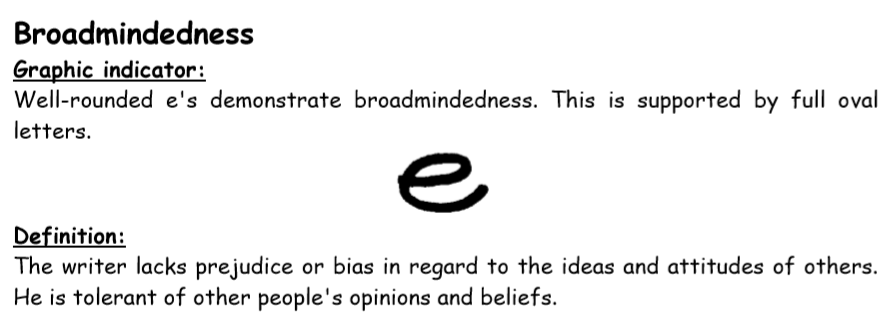
⇓ ⇓ ⇓
EVALUATED Traits for Broadmindedness:
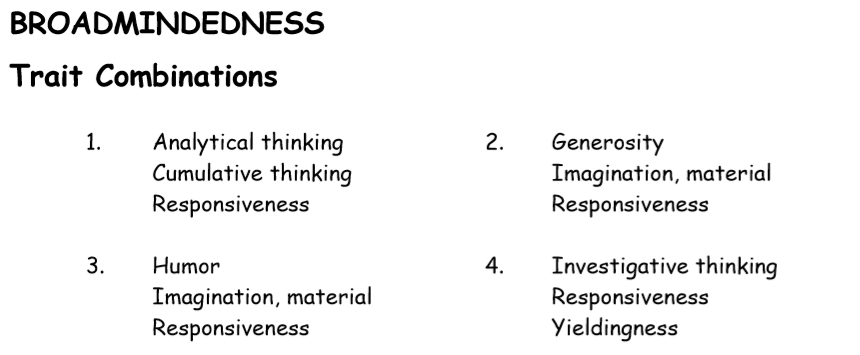
With Completed Descriptions for Each Combinations!
⇓ ⇓ ⇓
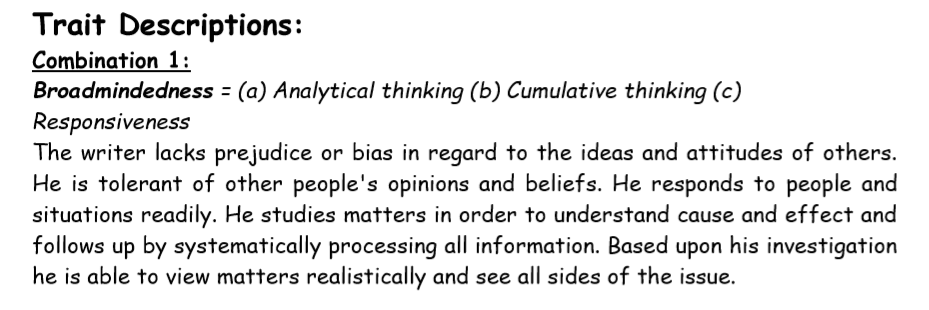



Another Example
EVALUATED TRAITS for Desire for Changes:
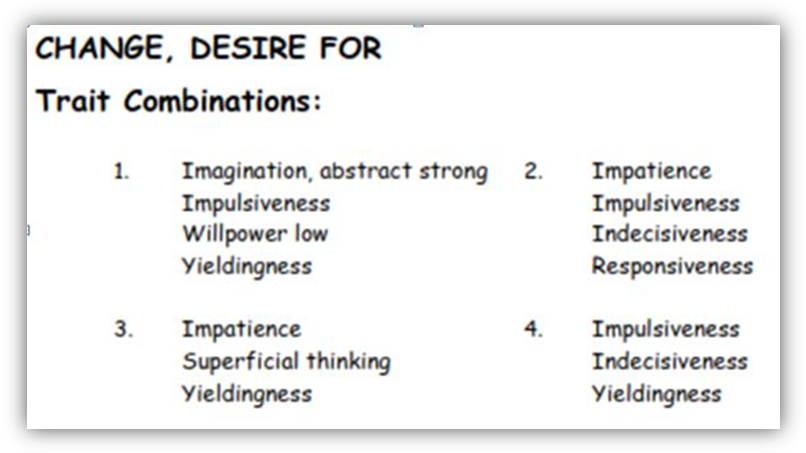
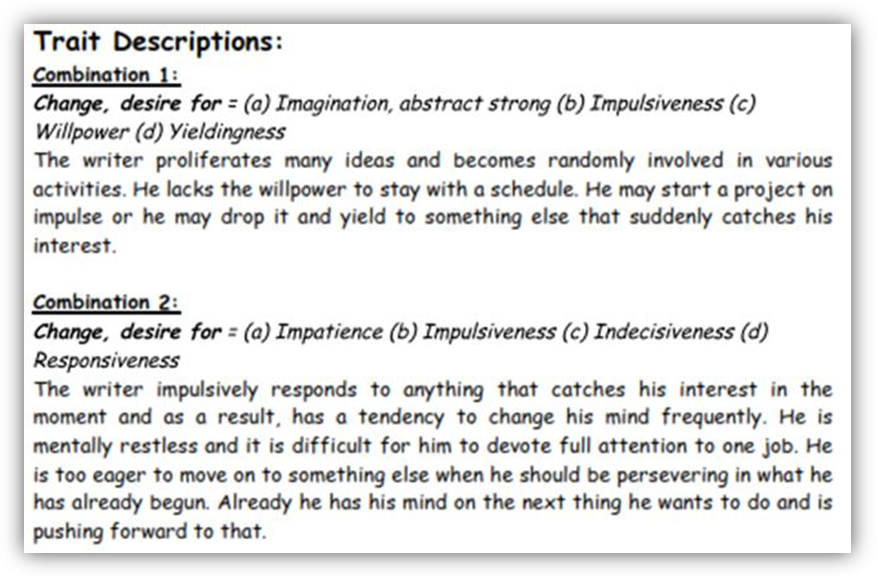
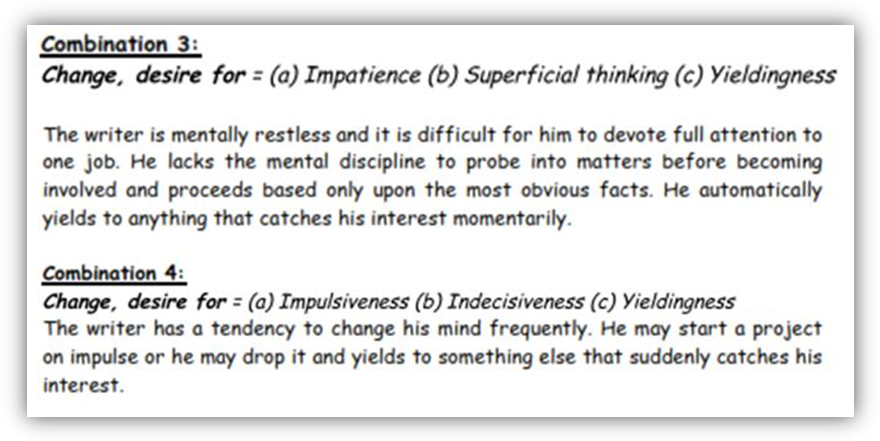
Free Diploma!
Upon completion of the course, students may apply for a Diploma as “Certificate of Completion for Evaluated Course” The diploma test is included with the study materials package. There is no charge for the diploma.
Important notice for home study program students! The Karohs International School of Handwriting Analysis is not an accredited school and there is currently no official licensing agency for graphology; therefore, diplomas are not officially accredited. The diplomas issued by the KAROHS International School of Handwriting Analysis® certify that graduates have successfully completed a study course and have complied with all the requirements for the completion of the course.
Because Dr. Karohs is recognized as a one of the world’s foremost graphologists and her courses are unquestionably unmatched by other courses currently available, diplomas issued by the KAROHS International School of Handwriting Analysis® and graduates trained by Dr. Karohs are highly esteemed both in the graphological and corporate world.
Important notice for University program students! The diplomas for university program students will be issued by the KAROHS International School of Handwriting Analysis® in unison with Maranatha University.
Our student comments speak for themselves:
Dear Dr. Erika Karohs, I do not know how I can thank you for your amazing home study course “Evaluated Traits Course of Handwriting Analysis”. I do not find adequate words to describe your publications which are well organized and are designed in professional way. They really are valuable and rich in information and illustrations.
The Evaluated course is taught by a practicing graphologist with a Masters degree or a Ph. D. in psychology and advanced knowledge about the course. At the KAROHS International School of Handwriting Analysis®, a degree in psychology is a MUST for ALL trainers.
REGISTER NOW!!!
PRINTED VERSION
$366 $227
Free Shipping Worldwide !!! (The books and study materials will be sent to you promptly.)
PDF VERSION
$227 $97 $77
For PDF version, the Books & Studey material will be sent to you through email attacmhent
A Few Words about Evaluated Traits
Most handwriting analysts are familiar with basic traits. One letter or stroke symbolizes a certain characteristic. Basic traits go back a long time.
More than a hundred years ago, the French Abbé Jean Hypolyte Michon tried to establish a reliable system of handwriting analysis. He collected thousands of writings and interpreted minute details.
In 1875, he published his most important book Système de Graphologie, in which he tried to prove that certain strokes in handwriting (signes fixes) manifest a specific trait of character. Although he depended on empirical observation alone, he was quite successful in his work and at the time of his death in 1881, his signes fixes numbered in the hundreds.
Some of the (signes fixes) listed in his book were:
-
Initial hooks = acquisitiveness
-
Long, curved finals = generosity
-
Jabbed i-dots = irritability
-
High upper zone = mental interest
-
Rising lines = optimism
-
Even upper/lower loops = organization
-
Slanted writing = emotionality
-
Long finals at end of line = caution
-
Lacking initial strokes = directness
-
Ovals with angular hooks = evasiveness
-
Curved strokes = humor
-
Ovals closed with several loops = deceit
After Michon’s death, Jules Crépieux-Jamin became the most important French graphologist. To him we owe the so-called “Theory of Resultants” which distinguishes between primary and secondary traits. In his book, “L’ECRITURE ET LE CARACTERE” (Paris 1889), he theorized that only the primary traits show. The secondary or “resulting” characteristics have to be evaluated through combinations of primary or basic traits.
Crépieux-Jamin called these evaluated traits resultants. Some of the resultants listed in his book L’Écriture Et Le Caracterè are:
- Weak will + imagination = fear
- Evasiveness + dishonesty = tendency to steal
- Sensitiveness + weak will power + self-underestimation = timidity
- Generosity + responsiveness + enthusiasm = empathy
Crépieux-Jamin examined hundreds of handwriting specimens to illustrate how a clustering of basic traits creates a certain evaluated trait. Crépieux-Jamin believed the procedure of establishing evaluated traits or resultants to be one of the most intriguing aspects of graphology.
Crépieux-Jamin claimed that every characteristic in the personality can be found in the writing, either as a basic or as an evaluated trait.
Today, the concept of evaluated traits has become an important part of most contemporary schools of handwriting analysis.
If you would like to learn to work with evaluated traits, or if you would like to refresh your knowledge about evaluated traits, the Evaluated Traits Course is certainly for you.



